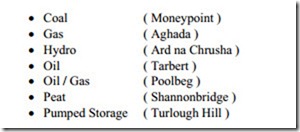Electricity Distribution Network
The Electricity Supply Board ( ESB ) operates 19 major power stations and is responsible for the generation, transmission and distribution of electricity in Ireland. The ESB is also the largest provider of renewable power, with hydro-electric power stations on the Erne, the Shannon, the Lee and the Liffey. A wholly-owned subsidiary of ESB, Hibernian Wind, is developing and operating wind farms.
Generation of Electricity
Many types of fuel are used to create steam and rotate turbines, which are coupled to 3-Phase AC generators. These generators produce electricity at 10,000 Volts ( 10kV ) 50 Hz.
A sample of the range of energy sources used by ESB generating stations is as follows:
Distribution of Electricity
The National Grid is an electricity transmission network of lines and cables throughout the country. It operates at very high voltages ( up to 400,000 Volts ).
At power stations, electricity is transformed to the higher voltage levels of 110,000, 220,000, or 400,000 Volts. It is then fed into a transmission network of approximately 6,000km of overhead lines and underground cables. These cables carry the electricity throughout the country. This network incorporates over one hundred high voltage transformer stations. At these stations the voltage is reduced to distribution voltages of 38,000, 20,000 and 10,000 Volts. Some larger industrial premises are supplied directly at these voltages.
Electricity is distributed at these ‘medium’ level voltages over an extensive distribution network of 80,000km of overhead lines and underground cables to smaller local substations close to customers’ premises. At the local substations, it is finally transformed down to the normal mains voltage level for use by customers.
By using very high voltages, the amount of energy that is wasted as heat, due to resistance in the transmission cables is greatly reduced. For every doubling of the transmission voltage, the amount of power wasted, is reduced by 75%.
